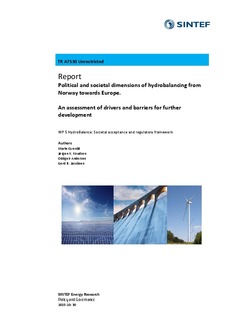| dc.contributor.author | Qvenild, Marte | |
| dc.contributor.author | Knudsen, Jørgen K. | |
| dc.contributor.author | Andersen, Oddgeir | |
| dc.contributor.author | Jacobsen, Gerd B. | |
| dc.date.accessioned | 2015-12-15T11:19:50Z | |
| dc.date.available | 2015-12-15T11:19:50Z | |
| dc.date.issued | 2015 | |
| dc.identifier.citation | Qvenild, M., Knudsen, J. K., Andersen, O., Jacobsen, G. B. 2015. Political and societal dimensions of hydrobalancing from Norway towards Europe. An assessment of drivers and barriers for further development. - TR A7530. 64 s. | nb_NO |
| dc.identifier.isbn | 978-82-594-3643-6 | |
| dc.identifier.uri | http://hdl.handle.net/11250/2367731 | |
| dc.description.abstract | This report provides an assessment of non-technical drivers and barriers influencing further development of the hydrobalancing potential from Norway towards European countries. The rising shares of intermittent renewable energy in Europe will increase the needs for balancing and storage capacity, and Norwegian hydrobalancing is interesting in this regard. Realizing hydrobalancing services from Norway will to larger extent depend on the EU development of a system for exchanging and valuing balancing services from renewable sources such as hydro power. In addition, the right drivers need to be in place at the Norwegian national level. A major barrier is currently the lack of comprehensive political strategies and necessary measures to relize increased hydrobalancing from Norway.
Both the "sceptics" and "supporters" amongst social stakeholders generally endorse interconnector projects towards Europe, like the new projects to Germany and the UK, but they do not currently demand hydrobalancing at a large scale. Still, given the probability of changes in the European energy system, as well as changes in the Norwegian economy, the overall picture can change rapidly. Consequently Norway could benifit from a more strategic thinking and approach towards hydrobalancing, where hydropower and grid facilities are considered as parts of a whole - and where the issue of societal acceptance is substantially addressed also at the local level. | nb_NO |
| dc.language.iso | eng | nb_NO |
| dc.publisher | SINTEF Energi AS | nb_NO |
| dc.relation.ispartofseries | SINTEF-rapport;TR A7530 | |
| dc.subject | hydrobalancing | nb_NO |
| dc.subject | policy framework | nb_NO |
| dc.subject | governance | nb_NO |
| dc.subject | social acceptance | nb_NO |
| dc.subject | planning | nb_NO |
| dc.subject | regulations | nb_NO |
| dc.subject | hydropower | nb_NO |
| dc.subject | grids | nb_NO |
| dc.subject | interconnectors | nb_NO |
| dc.subject | politisk rammeverk | nb_NO |
| dc.subject | regjering | nb_NO |
| dc.subject | planlegging | nb_NO |
| dc.subject | regulering | nb_NO |
| dc.subject | nett | nb_NO |
| dc.subject | kabler | nb_NO |
| dc.title | Political and societal dimensions of hydrobalancing from Norway towards Europe. An assessment of drivers and barriers for further development | nb_NO |
| dc.type | Research report | nb_NO |
| dc.source.pagenumber | 64 s. | nb_NO |
| dc.relation.project | SINTEF: 502000131 | nb_NO |
